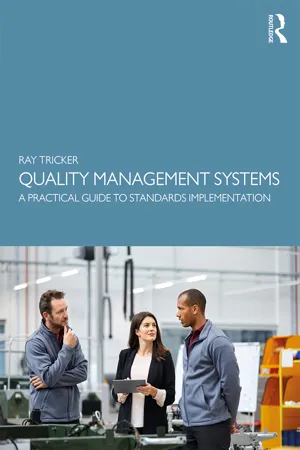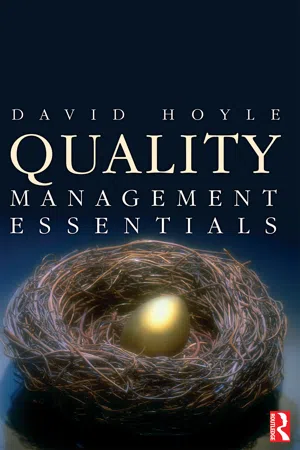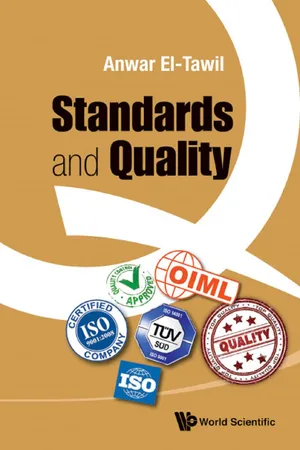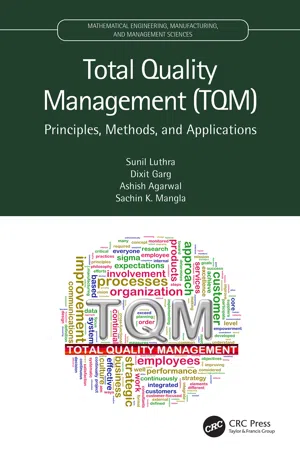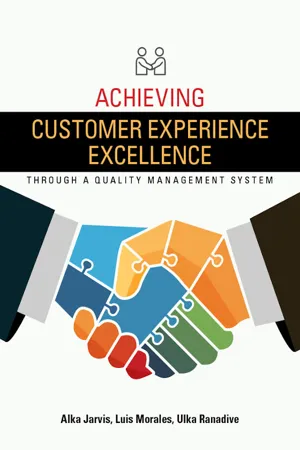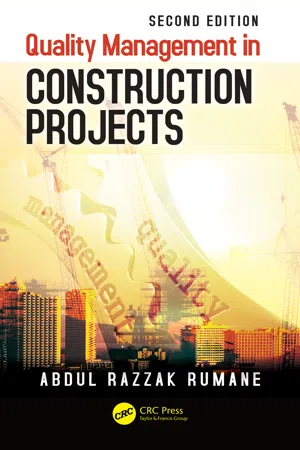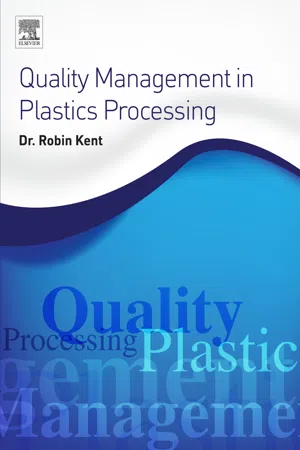Technology & Engineering
ISO 9001 Quality Manual
The ISO 9001 Quality Manual is a document that outlines an organization's quality management system, including its policies, procedures, and processes. It serves as a guide for ensuring that products and services consistently meet customer requirements and regulatory standards. The manual is a key component of ISO 9001 certification, demonstrating an organization's commitment to quality and continuous improvement.
Written by Perlego with AI-assistance
Related key terms
Related key terms
1 of 4
Related key terms
1 of 3
10 Key excerpts on "ISO 9001 Quality Manual"
- eBook - ePub
Quality Management Systems
A Practical Guide to Standards Implementation
- Ray Tricker(Author)
- 2019(Publication Date)
- Routledge(Publisher)
ProcessesThe core business process plus supporting processes that describe the activities required to implement the QMS and to meet the policy requirements shown in the Quality ManualLevel 3ProceduresA description of the method by which quality system activities are managedLevel 4Work InstructionsA description of how a specific task is carried out1.5.1 Quality Manual
A Quality Manual shows how an organisation meets the requirements of a specific Management Systems Standard (or a number of associated standards) and defines:- the overall quality policy adopted by that organisation;
- the organisation that has been developed to implement this quality policy;
- the documentation (i.e. Quality Processes, Quality Procedures and Work Instructions) that has been designed to enable that particular organisation to carry out that policy.
Author’s Hint
Organisational changes within a company or the environment in which it operates may necessitate modifications, amendments, insertions and/or deletions to the overall QMS adopted by that particular company and its associated documentation. The contents of this Quality Manual may therefore be altered on an as required basis – but, all changes must be subject to a Quality Procedure for the Control of documented information. Changes are deemed operational following approval by the authorised person(s) and published as updated sections of the Quality Manual.The Quality Manual is a statement of the managerial policy and the objectives for each clause of ISO Annex SL (and/or an associated Management System Standard), and, as such, it provides a statement of commitment to customers (or external approval and/or regulatory bodies when required. The Quality Manual describes a number of systematic controls and procedures for the Staff in fulfilling their duties and responsibilities. It defines the lines of traceability, accountability and responsibility and exists primarily as an internal management control document. The Quality Manual also provides a definitive statement of the policy, objectives, operating systems, processes and procedures established by the organisation, and the system recognises the established elements of modern formalised quality management as expressed in national and international standards and as appropriate to the nature of the work undertaken. (See Figure 1.18 - eBook - ePub
- David Hoyle(Author)
- 2007(Publication Date)
- Routledge(Publisher)
- Determine the processes and responsibilities necessary to attain the quality objectives.
- Determine and provide the resources necessary to attain the quality objectives.
- Establish methods to measure the effectiveness and efficiency of each process.
- Apply these measures to determine the effectiveness and efficiency of each process.
- Determine means of preventing nonconformities and eliminating their causes.
- Establish and apply a process for continual improvement of the quality management system.
The four sections of ISO 9001 contain requirements that embody this approach but also prescribe requirements derived from the quality management principles that were addressed in Chapter 2 . The requirements are not presented in any specific order or as a process and in some respects they follow no particular prescription except that they arise from failures that experience had shown led to poor product quality. The sections of ISO 9001 and ISO 9004 are as follows:Introduction.- Scope.
- Normative references.
- Terms and definitions.
- Quality management system.
- Management responsibility.
- Resource management.
- Product realization.
- Measurement, analysis and improvement.
Quality management system (development)
Section 4 of ISO 9001 contains the basic requirements for establishing a management system rather than any particular component of the system. In some instances they are duplicated in other Clauses of the standard but this is no bad thing because it emphasizes the principle actions necessary to develop, implement, maintain and improve such a system. Unlike previous versions, the focus has moved away from documentation towards processes and therefore these general requirements capture some of the key activities that are required to develop an effective system. - eBook - ePub
Total Quality Management
Text, Cases, and Readings, Third Edition
- Joel E. Ross(Author)
- 2017(Publication Date)
- Routledge(Publisher)
The series is produced in five parts: ISO 9000, 9001, 9002, 9003, and 9004. ISO 9000 and 9004 are guidelines, whereas ISO 9001, 9002, and 9003 are the categories for which companies may apply for certification.ISO 9000, “Quality Management and Quality Assurance Standards—Guidelines for Selection and Use,” is an advisory document. It explains how the overall standard is divided, gives guidelines to use in determining which of the three classifications (9001, 9002, 9003) is applicable to a business, and gives guidelines on how the systems may be implemented.The three components of ISO 9000 and the 20 subclauses of the quality requirements for ISO 9001 to 9004 are shown in Figure 12-1 , arranged in three major blocks. The central block of nine clauses is considered the core requirements because these relate to what happens in the operating process itself. Very broadly, this term covers input, what is done with the input (i.e., the process), and the output (i.e., what goes out to the customer). The sections in the left and right blocks have a supporting rather than a core role but are just as essential as those in the central operating process block. To meet the standard, a quality system must be shown to fulfill the requirements under Quality System Control and support activities as fully as those included under Operating Process.The requirements of the three components of ISO 9000 (Figure 12-1 )20 are outlined below.Operating Process The requirements included under Operating Process are described briefly here. Any reader who intends to design a quality system to meet ISO 9001, however, should obtain and read the actual standard. Contract ReviewOne of the fundamental aspects of quality is meeting the customer’s requirements. Clearly, to meet these requirements a supplier must know what they are. Contract review is concerned with adequately defining and documenting these requirements and establishing that the resources needed to meet them are available. What should be covered in such a record of requirements and how it should be documented will vary from business to business. - eBook - ePub
- Anwar El-Tawil(Author)
- 2014(Publication Date)
- WSPC(Publisher)
A fourth situation also exists, where an organization or a corporation decides to use the principles of ISO 9000 standards to improve the quality of its products and services, but is not interested in certification. In this case, the organization should implement the approaches and techniques provided in the ISO 9004 standard, which gives guidance on a wider range of objectives of a quality management system than does ISO 9001, particularly in managing for the long-term success of an organization. ISO 9004 is recommended as a guide for organizations whose top management wishes to extend the benefits of ISO 9001 in pursuit of systematic and continual improvement of the organization’s overall performance. However, ISO 9004 is not intended for certification or contractual purposes.It is worthwhile reminding the reader that, ISO 9001 prescribes Quality System Requirements, which are distinct from the Technical Requirements of Product and Technical Requirements of Processes. The three sets of requirements are complimentary, but neither can replace the others.7.5 IMPLEMENTATION OF ISO 9000 IN THE WORLDSince the first ISO 9000 standards were published in 1987, a spectacular increase in the number of organizations implementing them and obtaining certification was witnessed. By the end of 2013, over 1.1 million organizations have been certified to ISO 9001 in 170 countries (Figure 11 - eBook - ePub
Total Quality Management (TQM)
Principles, Methods, and Applications
- Sunil Luthra, Dixit Garg, Ashish Agarwal, Sachin K. Mangla(Authors)
- 2020(Publication Date)
- CRC Press(Publisher)
10 Quality Management Systems10.1 QUALITY MANAGEMENT SYSTEMS
Quality management systems or quality systems may be defined as techniques/ methodologies a manufacturer must follow to ensure that all the products manufactured meet the specifications. Discussing a quality system means ‘talking about a standard.’ Initially, there are two quality systems:- Military Quality System.
- ISO 9000 Quality System.
10.2 MILITARY QUALITY SYSTEM
The Department of Defence approved this quality system and made it mandatory to be used by the departments of the Army, Navy, Air Force, and Defence Supply Agency. The military quality system helps in establishing the requirements for a contractor’s inspection system. The various requirements of this system are:- Contractor responsibilities.
- Inspection and testing documentation.
- Records.
- Corrective actions.
- Drawings and changes.
- Measuring and testing equipment.
- Process controls.
- Indication of inspection status.
- Government-furnished material.
- Non-conforming materials.
- Quality products.
- Sampling inspection.
- Inspection provisions.
- Government inspection at subcontractor or vendor facilities.
10.3 ISO 9000 QUALITY SYSTEM
The ISO 9000 quality management system was first published by the International Organisation for Standardisation in 1987. ISO 9000 can be defined as a group of international quality management standards which was developed to ensure that organisations fulfil the needs of clients and partners while meeting legal and administrative requirements associated with a product or service.ISO 9000 is not limited to any specific industry and it is applicable to all the organisations willing to maintain the quality in their products. The national standards body of the United Kingdom, known as the British Standards Institution (BSI), proposed the BS 5750 series of standards to ISO in 1979. So, the BS 5750 series of standards were the basis for ISO 9000. However, around 20 years prior to BS 5750 series of standards, there were some standards for procurement by government, e.g., the MIL-Q-9858 standard in 1959 used by the US Defence system. - eBook - ePub
The Quality Audit for ISO 9001:2000
A Practical Guide
- David Wealleans(Author)
- 2017(Publication Date)
- Gower(Publisher)
For management auditing, it is probably best to avoid the discussion as to whether we are auditing functions, but ensure that we are looking at areas which are not too narrow, which are coherent and which have clearly defined interfaces. This is not to say that process management has no use in the field of quality management. There are many process management initiatives which have brought great benefit to their respective organizations. Just do not become too worried about whether it is a process or not when conducting quality audits.QUALITY MANAGEMENT SYSTEMS
Just as we have said that quality management is about coordinating all the activities that go towards achieving customer satisfaction, so a quality management system is a defined set of rules and disciplines which cover how we are going to manage quality. Since the word ‘system’ is used, this implies that it has been consciously designed and forms an integrated whole. Thus while organizations who have gradually grown up with a range of individual disciplines and standard approaches can achieve ISO 9001 certification, this would still not be classed as a quality management system by purists.In practice, a quality management system is usually what organizations create when they are seeking ISO 9001 certification. The typical process is to pool together what we already have and fill in any gaps by documenting a few more standard disciplines such as an audit programme. A quality manual is then produced, ostensibly to pull everything together and provide a central focus, but normally it is a boring document to read and attended to by nobody other than the certification assessor and the occasional quality manager of large customers (who must have copious quantities of time to spare to want to read these documents).From an auditor’s point of view, this ‘getting by’ approach to defining the system for certification purposes is not necessarily a problem. This is because what is thought of as the quality management system in an organization does not necessarily reflect the real and complete system. For a start, managers often think of the quality system as comprising only elements which have an impact on their ISO 9000 certification. This is clearly not true; there are other factors which impact upon the customer which tend to lie outside the scope of the standard (image, speed of response, advertising, cost, payment terms and procedures and so on). - Alka Jarvis, Luis Morales, Ulka Ranadive(Authors)
- 2016(Publication Date)
- ASQ Quality Press(Publisher)
The closest to DMS we have seen are the ISO/TC 171 Document Management applications, whose scope is to identify standardization of technologies and processes related to capturing, indexing, storage, retrieval, distribution and communication, presentation, migration, exchange, preservation, integrity maintenance, and disposal in the field of document management applications. The documents may be managed in micrographic or electronic form. This includes:- Quality control and integrity maintenance
- Input/output quality of documents (micrographic or electronic)
- Implementation, inspection and quality control procedures for storage, use, and preservation of documents (micrographic or electronic), including supportive metadata
- Applications involving workflow (process management) in an enterprise and on the Internet
- Maintenance of quality and integrity during information exchange between systems
- Procedures and processes supporting legal admissibility and/or integrity and security
- Management of related audit trail information
(Source: ISO Website for ISO/TC 171)3.7 INTEGRATION OF MANAGEMENT SYSTEMS STANDARDS AND QMSThe challenge of implementation and maintenance of various management standards such as quality, environment, and others are faced on a daily basis. Generally these standards have their own processes, policies, and documentation and are implemented as stand-alone management systems. The maintenance of several standards in an organization becomes a huge, time-consuming financial burden that utilizes several resources. To address this, the concepts of integration of various management systems standards was introduced by a high level structure (HLS) requirement with same sub-clause names, common texts, and terms and definitions for easier management and operations.Combining all components of a business into one system to meet customer expectations and achieve business goals is known as an integrated management system (IMS). The net result is that all processes and related documents for quality (QMS), environmental (EMS), and safety (OHSMS) management systems are often combined and managed seamlessly as an IMS, avoiding duplication. This results in reduction of costs, increase in profitability, creation of consistency, improvement in communications, and makes employees easier to train.- eBook - ePub
- Abdul Razzak Rumane(Author)
- 2017(Publication Date)
- CRC Press(Publisher)
(Source : Feigenbaum, A.V. (1991), Total Quality Control, Reprinted with permission of The McGraw-Hill Education.) Quality engineering becomes the field, or apex, of the triangle. The technical work area of the discipline—quality systems implementation—is shown in the first tier. The second tier then shows the principal techniques of quality engineering technology. Quality engineering relates the particular requirements of the plant and companies to the available quality technology—including both hardware equipment and planning and control actions—to put in place much of the ongoing operating detail of the quality systems framework for the firm. Quality engineering technology thus provides the technical areas to deal with such questions as the following: What are the specific details of the control activities to take place during the development and production and service cycles? Will these quality activities best be accomplished through the use of quality information equipment or by the use of people guided by procedures? What information and material inputs will be needed? What type of information data is required? How should it be analyzed, and what sort of feedback should be used? Depending upon the differences in the product-quality levels encountered, what criteria are there for alternative courses of corrective action? Feigenbaum (1991) has further elaborated the entire range of techniques used in quality engineering technology by grouping them under three major headings: Formulating of quality policy. Included here are techniques for identifying the quality objectives and quality policy of a particular company as a foundation for quality analysis and systems implementation. Product-quality analysis. Techniques for analyzing include those for isolating and identifying the principal actors that relate to the quality of the product in its served market - eBook - ePub
ISO 9001
2015 - A Complete Guide to Quality Management Systems
- Itay Abuhav(Author)
- 2017(Publication Date)
- CRC Press(Publisher)
Clause 4.4.1 is a declaration of the standard’s intention regarding the QMS. In this clause, the requirements and main principles of a QMS are presented. This clause can be regarded as a foundation for self-evaluation of whether the organization’s QMS follows the general requirements. First let me review the basic requirements:• The organization shall establish, implement, and maintain a QMS within the organization with conformity to the requirements of the ISO 9001 Standard. • The organization is required to continually improve the QMS and its processes in accordance with the requirements of this International standard. • The organization shall determine the processes needed for the QMS. • The organization shall determine how these processes will be applied in the QMS. • The processes included in the QMS shall be identified and planned, implemented, controlled, and improved. • The organization shall determine the required inputs and expected outputs of every process. • The organization shall determine the sequence and interaction of processes included in the QMS. • The organization shall determine how these processes and their controls will be implemented in the organization. • Methods, criteria, performance indicators, and measurements for ensuring effective monitoring and control of the processes will be defined and implemented. • Resources needed to support these processes shall be allocated and available. • Responsibilities and authorities for these processes shall be assigned. • Risks and opportunities identified and determined in accordance with the requirements of 6.1 shall be addressed. • Changes necessary to ensure processes achieve their intended results shall be evaluated, planned, and implemented. • The organization will implement specific measures for the improvement of these processes (achievement of objectives and maintenance of effectiveness). - eBook - ePub
- Robin Kent(Author)
- 2016(Publication Date)
- William Andrew(Publisher)
Tip - Existing systems can be adapted to ISO 9001. The best method is to document the existing processes and systems. These can then be considered against the ISO 9001 requirements and new elements introduced only where the existing processes do not meet the requirements. This is more work for the consultant but less disruptive for the company.ISO 9001 requires documented information but does not specify how this should be set out, written or stored. This can be on paper (text or flow charts) or on computers (text or flow charts). This is an operational decision for the company.Maintained Documents (5) ■ Scope of the QMS (4.3).■ Operation of processes (4.4.2).■ Quality policy (5.2.2).■ Quality objectives (6.2.1).■ Control of production and service provision (8.5.1).Retained Records (23) ■ Operation of processes (4.4.2).■ Monitoring and measurement Resources (7.1.5.1).■ Measurement traceability (7.1.5.2).■ Competence (7.2).■ Operational planning and control (8.1).■ Requirements review (8.2.3).■ Design and development:• Planning (8.3.2).• Inputs (8.3.3).• Controls (8.3.4).• Outputs (8.3.5).• Changes (8.3.6).■ Externally provided products and services (8.4.1).■ Control of production and service provision (8.5.1).■ Traceability (8.5.2).■ Property belonging to customers/external providers (8.5.3).■ Control of changes (8.5.6).■ Release of products and services (8.6).■ Control of nonconforming outputs (8.7.2).■ Monitoring, measurement, analysis and evaluation 9.1.1).■ Internal audit (9.2.2).■ Management review (9.3.3).■ Nonconformity and corrective action (10.2.2).The documented information required by ISO 9001 The documented information required for ISO 9001 should be either maintained, e.g. process and procedure information, or retained, e.g. records of processes and procedure operation.Maintained documents
Several sets of documented information are required to be ‘maintained’ by ISO 9001 and these are listed on the left.This documented information can be maintained via a ‘company quality brochure’ (see Section 4.8
Index pages curate the most relevant extracts from our library of academic textbooks. They’ve been created using an in-house natural language model (NLM), each adding context and meaning to key research topics.
Explore more topic indexes
Explore more topic indexes
1 of 6
Explore more topic indexes
1 of 4
